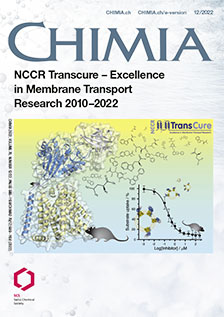New Insights into the Physiology of Iron Transport: An Interdisciplinary Approach
DOI:
https://doi.org/10.2533/chimia.2022.996PMID:
38069794Keywords:
Bone, DMT1, FPN, Iron homeostasis, PlacentaAbstract
The TransCure project entitled 'Iron Transporters DMT1 and FPN1' took an interdisciplinary approach combining structural biology, chemistry and physiology to gain new insights into iron transport. Proteins studied included Divalent Metal Transporter 1 (DMT1, SLC11A2), enabling the import of Fe2+ into the cytoplasm, and the iron efflux transporter Ferroportin (FPN1, SLC40A1). The physiology and pathophysiology, and the mechanisms underlying iron transport in the gut, across the placenta and in bone were investigated. Small molecule high-throughput screening was used to identify improved modulators of DMT1. The characterization of DMT1 inhibitors have provided first detailed insights into the pharmacology of a human iron transport protein. In placental physiology, the identification of the expressional and functional alterations and underlying mechanisms in trophoblast cells clarified the association between placental iron transport by DMT1/FPN1 and gestational diabetes mellitus. In bone, iron metabolism was found to differ between cells of the monocyte/ macrophage lineages, including osteoclasts. Osteoclast development and activity depended on exogenous iron, the expression of high levels of the transferrin receptor (TFR) and low levels of FPN1 suggesting the expression of an “iron storage” phenotype by these cells. The principles and main findings of the TransCure studies on transmembrane iron transport physiology are summarized in this review.
Funding data
-
Schweizerischer Nationalfonds zur Förderung der Wissenschaftlichen Forschung
Grant numbers 51NF40-185544;310030_197408;310030_182272
Grant numbers 51NF40-185544;310030_197408;310030_182272
Downloads
Published
How to Cite
Issue
Section
License
Copyright (c) 2022 Christiane Albrecht, Jonas Zaugg, Jonai Pujol Giménez, Romina Cabra, Wilhelm Hofstetter, Matthias Hediger

This work is licensed under a Creative Commons Attribution 4.0 International License.







